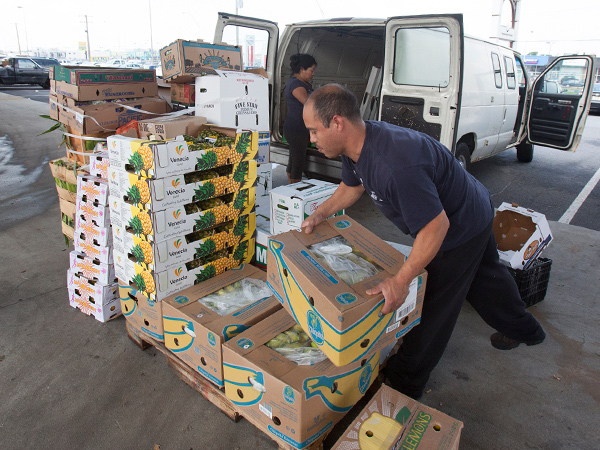PhillyDeals: Phila. Wholesale Produce
Market is bearing fruit

The Philadelphia Wholesale Produce Market
located in West Philadelphia, a 3-year-old facility near the airport, has
become a model for other markets planning to modernize. Here, Lucio Ramos and
his wife, Sara, load fruit and vegetables into their van. Sara owns Sara's
Produce in Collingswood, N.J. (ED HILLE/Staff photographer)
We're a little bit
jealous of Philadelphia," says Matthew D'Arrigo, produce
wholesaler and market officer at Hunts Point Terminal, the big New York
distribution center that will move $2.5 billion worth of food this year. D'Arrigo
is talking about his Philadelphia rivals' success at getting the Philadelphia
Wholesale Produce Market built. That quarter-mile-long, multi-story,
skylit, fully refrigerated fruit and vegetable warehouse and showcase just
celebrated its third anniversary on Essington Avenue in Southwest Philadelphia.
And it's growing, says Sonny
DiCrecchio, the Philadelphia produce broker turned market chief executive
and president: Sales at the new market will approach $1.6 billion this year, up
from $1 billion when it was proposed in the mid-2000s. The market now employs
1,500, up from 1,100 at the former Philadelphia Regional Produce Terminal on
Galloway Street in South Philly.
It expects to pay
Philadelphia $7 million in wage and business taxes this year, up from $3.8
million before the move. On the other hand, just 25 produce firms now operate
in the new center, down from 40 at the old terminal, though surviving firms
have expanded to fill the available space. "Here, the overhead is higher.
You have to sell more product," says broker John Vena.
"The rent is 21/2 times what we paid in the old neighborhood."
But he's getting more
for that money, Vena added: "The cost here includes central refrigeration.
On the old market we paid for our own." He welcomes the centralized
recycling, the 54-inch rodent wall that steers varmints away ("We see more
deer than rodents here," DiCrecchio said), the tight entry security, and
especially the central refrigeration system covering storage, work, and loading
docks. "We have less spoilage. Much better shelf life. Much better
security," Vena concludes. "They are giving their customer a stronger
product than before," Hunts Point's D'Arrigo said. At places like Hunts
Point or Philadelphia's former Galloway Street terminal, "when it's 25 or
95 degrees out, those open-air docks are tough," D'Arrigo said.
Crates of produce freeze
in an hour, or liquefy in the heat. Brokers have to time deliveries so boxes
don't stack up in those conditions. At the fancy new terminal, brokers still
have to hustle to attract buyers. On a typical day they draw more than 800
customers, from chain-store buyers with tractor trailers, to neighbors' groups
and corner bodegas. "They are competing with independent produce
distributors. The industry is consolidating. This market uniquely has a
high-tech facility," which gives it an edge, said Miriam Wolk,
vice president at United Fresh, a Washington produce advocacy
group. "It took a lot of courage for the city, the state, and the owners
to pony up for this," says Anthony Barbieri, the former head
Acme produce buyer who is now a senior official at the Produce
Marketing Association, in Newark, Del. "It was absolutely the right
thing to do for the longevity of this business in the city."
DiCrecchio says his hair
"went half-white" keeping the market's financial package together
after the 2008 financial crisis. Funding for the Brian O'Neill-built center
included: $152.5 million borrowed from the Philadelphia Regional Port
Authority, to be paid back over 40 years.A $50 million loan from American
International Group, which was nearly canceled when the insurer was taken
over by the government during the financial crisis. Public money, including an
$11 million PennVEST state-backed loan, a $3 million federal Housing and Urban
Development loan, a $2 million federal "brownfields" grant (the site
had held 200,000 discarded tires), all conditional for the larger loans.
Brokers credit produce
and political leaders for relentless advocacy, including former state Sen.
Vincent Fumo, (D. Phila.), who will be honored at a produce dealers'
luncheon later this year. "What now separates Philadelphia's wholesale
market is the assurance it's deemed
fresh for fruits and
vegetables," Barbieri told me. "The biggest-selling section of a produce
department today is bagged salads. These salads are fresher, and they last
longer at home. "If I'm a buyer, I'm going to be loyal to the product that
lasts longer, because I won't throw as much away."
No comments:
Post a Comment